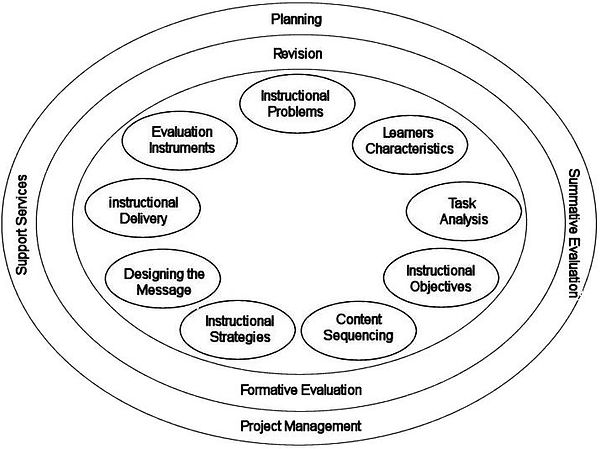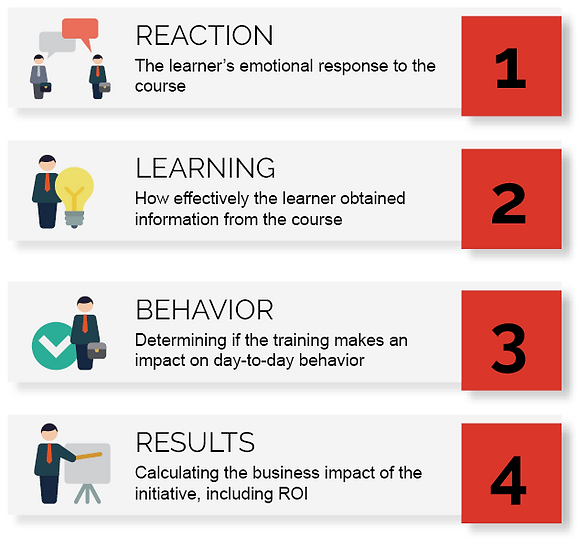Instructional Design Models
-
ADDIE
-
AGILE
-
ARCS
-
ASSURE
-
Dick and Carey Instructional Model
-
Gagne’s Nine Events of Instructions
-
Kemp Instructional Design Model
-
Kirkpatrick Model of Evaluation
-
Mayer's Principles of Multimedia Learning
-
MPI: Merirll’s Principle of Instruction
-
PADDIE + M
-
SAM
-
SMART
-
SUCCESS Model: Made to stick
1. ADDIE Model: Instructional Systems Design

The ADDIE model is the generic process traditionally used by instructional designers and training developers. The five phases—Analysis, Design, Development, Implementation, and Evaluation—represent a dynamic, flexible guideline for building effective training and performance support tools.
While perhaps the most common design model, there are a number of weaknesses to the ADDIE model which have led to a number of spin-offs or variations.
Key terms:
Analysis, Design, Development, Implementation, and Evaluation

2. AGILE Model
-
Align
-
Get set
-
Iterate and Implement
-
Leverage
-
Evaluate
3. ARCS Model: Motivational Design Theories
"Motivation is not from animation or games or any edutainment, but they are only attention-getting. Real motivation is from learning, motivation comes when students find out that they are able to do they weren't able to do before. The best motivation of all is for students to be able to learn some real world task. "
---Dr.Merrill
According to John Keller’s ARCS Model of Motivational Design Theories, there are four steps for promoting and sustaining motivation in the learning process: Attention, Relevance, Confidence, Satisfaction (ARCS).
Key terms:
Attention, Relevance, Confidence, Satisfaction
4. ASSURE Model
ASSURE is the brainchild of Heinrich and Molenda, and it’s ideally suited for blended learning environments. It consists of 6 stages: analysis, statement, selection, utilization, requirements, and evaluation.
-
Analyze
Research your learning audience and assess their pre-existing knowledge, preferences, and gaps. You must also consider their learning styles and backgrounds. -UDL -
State objectives
Clarify the objectives and what learners must accomplish by the end of the course/activity. -
Select the right media
Choose the best delivery vehicle based on the subject matter, objectives, and learner demographics. For example, case studies and real-world examples will help employees put the information into context./ and choose the up to date material -
Utilize technology and multimedia
Create a game plan for how you will use tech tools and media to achieve the objectives. -
Require learners’ attention and performance
Determine the best way to engage learners and elicit performance so that they connect with the content. -
Evaluate and revise
Analyze how the content is received and if it meets learners’ expectations. Did it achieve the desired outcomes? Can you improve the design to achieve better results?
5. Dick and Carey Model
Dick and Carey instructional design model (also known as the Systems Approach Model) focuses on how to make the lesson plans. Despite the seemingly complicated diagrams below, the steps are often only connected as far as what they do to help you figure out what to teach and how to teach it. All ten steps are connected, and some influence others indirectly while they may influence others directly.


Read more about Dick and Carey Model at:
6. Gagne’s Nine Events of Instruction
Robert Gagne proposed a framework comprising of a series of events based on the behaviorist approach to learning.
These events follow a systematic instructional design process, creating a flexible model where events can be adapted to cater to different learning situations.
It is, in fact, one of the most used instructional design models as it provides a sound structure for developing effective eLearning.
The nine steps are:
-
Gain attention of the students —with stimuli that catch and engage their brain (novel ideas or thought-provoking question, etc.)
-
Inform students of the objectives — Establish the expected outcomes and criteria for measuring achievement.
-
Stimulate recall of prior learning —Leverage existing knowledge before introducing new knowledge and build on it.
-
Present the content — Deliver the content in easily consumable chunks.
-
Provide learner guidance — Guide them with examples, case studies, and other instructional support to supplement the content.
-
Elicit performance — Engage them with different activities that recall, utilize, and evaluate knowledge.
-
Provide feedback — Reinforce knowledge with immediate feedback (informative, remedial, corrective, etc.)
-
Assess performance —Test their knowledge with established (and transparent) criteria.
-
Enhance retention and transfer to the job — Use content retention strategies (concept maps, rephrasing, summarizing, job aids, etc.) --- to tell them what you're going to tell them, tell them, and finally tell them what you told them.
-
Inform employees about similar problem situations, provide additional practice and review the lesson.
-
Do not introduce new terminologies or concepts at this stage as you must focus on closing and completing the information transferred.
-
Adapted from:
Karla Gutierrez A Quick Guide to Four Instructional Design Models May 18, 2018 Shiftelearning
Robert Gagne's Nine Steps of Instruction: Do's and Don'ts in eLearning Mar 9, 2015 Origin Learning
7. Kemp Design Model
Kemp Instructional Design Model (also referred to as the “Morrison, Ross, and Kemp Model”) represents an innovative approach to instructional design by virtue of its non-linear structure, and the interrelated nature of its components.

Key terms:
Nine Core Elements
-
Determine the specific goals, and also identify potential instructional issues
-
Identify characteristics of learners that should be taken into account during the planning process
-
Clarify course content, and analyze the proposed task components in relation to the stated goals and purposes of the course
-
Define instructional objectives and desired learning outcomes
-
Ensure that content for each instructional unit is structure sequentially and logically to facilitate learning
-
Design instructional strategies to enable individual learners to master the content, and achieve desired learning outcomes
-
Plan the instructional message and the appropriate mode of delivery
-
Develop evaluation instruments suitable for measuring and assessing learners’ progress towards achieving course objectives
-
Choose the appropriate resources that will support both teaching and learning activities
8. Kirkpatrick Model:
The Kirkpatrick Model is probably the best known model for analyzing and evaluating the results of training and educational programs. It takes into account any style of training, both informal or formal, to determine aptitude based on four levels criteria.
Key terms:
Reaction, Learning, Behavior and Results.

10. Merrill's Principles of Instruction (MPI)
MPI is remembered as the first principles of instruction. Proposed by David Merrill in 2002, this framework holistically integrates 5 principles of learning, namely:
-
Task-centered principle:
-
Learning starts with real-world problems, students should be able to relate to problems and tasks they can handle.
-
-
Activation principle:
-
A course must activate existing knowledge base of the learner; hence aiding them connect previous knowledge with the new one.
-
-
Demonstration principle:
-
A course must demonstrate the knowledge (both visually and through story telling) so that it leverages different regions of the brain, hence retaining it longer.
-
-
Application principle:
-
Allow them to apply new information on their own. Let them practice and learn from their mistakes. Let them see how your material works in concrete situations.
-
-
Integration principle:
-
The course must offer possibilities for integrating the knowledge into the learner's world through discussion, reflection, and/or presentation of new knowledge.
-
Adapted from: Karla Gutierrez A Quick Guide to Four Instructional Design Models May 18, 2018 Shiftelearning
"Real learning takes place when we implement basic principles of instruction, and those basic principles include at least demonstrating what you gonna learn, having the students actually what do what they're learning and doing this in a context of a real world problem.
The best motivation of all is for students to be able to learn some real world tasks.
And I guarantee you that answering multiple-choice questions is not a real world task. So students want to be able to do things, they take courses because they'd like to be able to do things they'd like to be able to do something they couldn't do before. If we can identify what that is and we can present that as the very first part of our instruction and say at the end of this course, at the end of this module, you'll be able to do this task or you'll be able to make these predictions or you'll be able to perform in some way and then show them what they need to do in order to complete that whole task or perform in that way. Their motivation is going to be greatly increased.
So in summary, it just seems to me that there are 3 very essential things that I think everyone knows but we don't seem to do it very much in our instruction, and that is what we need to demonstrate what's going to be learned, we need to give students a chance to apply what they are going to learn and we need to do that in the context of real-world problems."
---Dr. Merrill
11. PADDIE + M Model
-
Planning
-
ADDIE:
-
Analysis
-
Topic Analysis
-
To succeed at this stage, you have to work with Subject Matter Experts (SMEs). They will provide you with their knowledge and existing training materials, such as PowerPoint presentations, presenter notes, reference documents, web resources, test questions, etc. It’s your responsibility to analyze these training materials (with the help of the SMEs) and to create content that is short, clear, concise, and engaging. Each learning objective needs to be presented with (key) information, case studies, real-life examples or scenarios, and a reference to additional learning resources covering the topic.
-
To analyze your training’s topics, you can ask your SMEs the following questions:
-
What do learners need to know to meet the learning objective?
-
What skills do learners need to perform the learning objective?
-
What are the activities (tasks, exercises, case studies, scenarios) that can help learners understand the content?
-
What are the most common mistakes people make (related to the topic)?
-
What are the most common questions that people ask (related to the topic)?
-
What is the information that is considered “obligatory”?
-
How will you assess the learners’ knowledge?
-
To analyze the existing training resources, you can use the following questions:
-
Are there any existing training materials that can ease the content development process (presentations, documents, manuals, specifications, videos, etc.)?
-
Do these materials contain all the necessary information? Are they outdated? Are there any inaccuracies? Are they interesting and engaging?
-
Is there any previous feedback on the quality of the training materials? What learners liked/disliked before?
-
Is there any missing information?
-
Why wasn’t the training considered successful before?
-
Resource: https://elearningindustry.com/online-training-content-development-tips
-
-
Design
-
Develop
-
Implement
-
Evaluation
-
-
Maintenance
12. SAM : Successive Approximation Model
-
Preparation Phase
-
Iterative Design Phase
-
Iterative Development Phase
-
Alpha, Beta and Gold Release
13. SMART Goal

14. SUCCESs Model: Make ideas stick
A sticky idea is understood, it’s remembered, and it changes something. Sticky ideas of all kinds—ranging from the “kidney thieves” urban legend to JFK’s “Man on the Moon” speech—have six traits in common. If you make use of these traits in your communication, you’ll make your ideas stickier.
You don’t need all 6 to have a sticky idea, but it’s fair to say the more, the better!
Key terms:
Simple, Unexpected, Concrete, Credible, Emotional and Stories.

